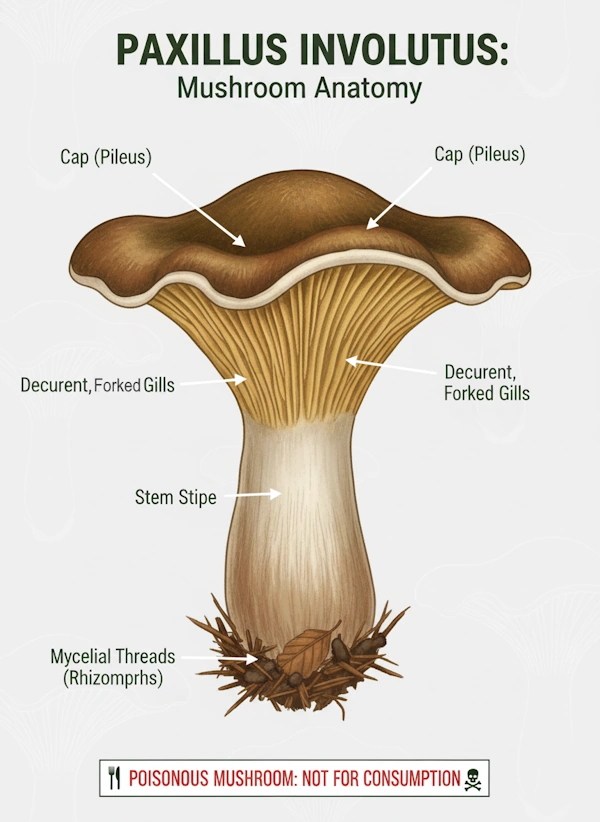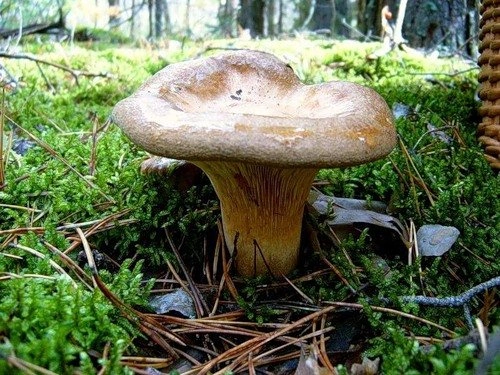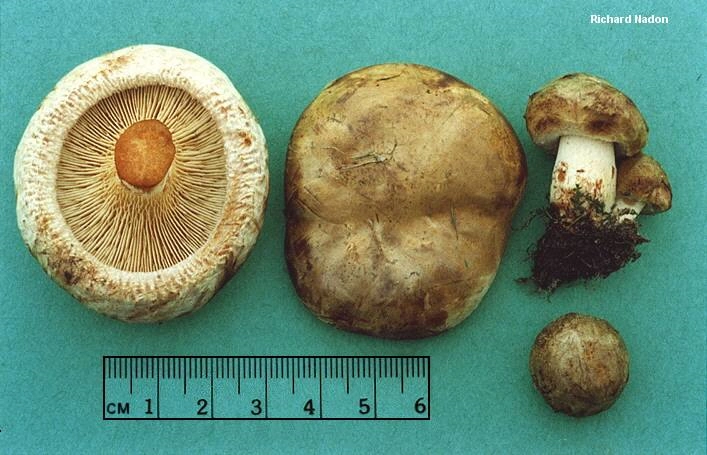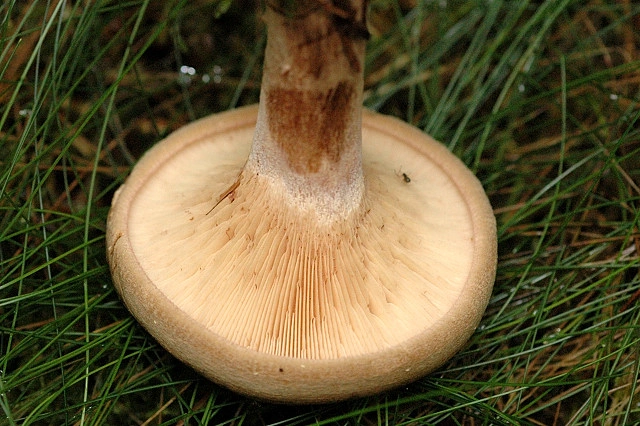Paxillus involutus, commonly known as the brown roll-rim mushroom, is a widespread fungus once thought edible but now recognized as poisonous due to its potential to cause severe health issues.
- It belongs to a species complex, not a single uniform species, with genetic variations across regions.
- It grows in forests and grasslands across the Northern Hemisphere, often forming symbiotic relationships with trees like birch and pine.
- The mushroom features a funnel-shaped brown cap with an inrolled edge, decurrent gills that bruise reddish-brown, and a short stem.
- Its toxins can trigger an immune response leading to hemolytic anemia, especially after repeated consumption, though not everyone is affected.
- Recognition relies on key traits like the rolled cap rim and bruising reaction, but confusion with similar species is common.
What kind of mushroom it is
This fungus falls under the basidiomycete group in the Boletales order, closely related to boletes despite having gills. It acts as an ectomycorrhizal partner to various trees, aiding nutrient exchange while thriving in acidic soils. Genetic studies suggest it’s part of a complex with multiple lineages, some potentially distinct species.
It is native to Europe, Asia, and North America, extending to Alaska and Greenland. Introductions have occurred in Australia, New Zealand, South Africa, and Chile, likely via soil on imported trees. It favors coniferous and deciduous woods, avoiding lime-rich areas.
The cap starts convex and becomes funnel-like, 4-15 cm wide, in shades of yellowish- to reddish-brown, with a sticky surface when wet and an inrolled margin. Gills run down the stem, fork, and stain brown when handled. The stem is 3-6 cm tall, solid, and matches the cap color. Spores are elliptical and brown.
It contains phenols like involutin and unidentified antigens that can cause Paxillus syndrome—an autoimmune hemolytic anemia. Initial gastrointestinal upset may occur if undercooked, but the main danger is cumulative: antibodies form over time, leading to red blood cell destruction, anemia, kidney damage, and potentially fatal shock. Symptoms start 1-3 hours after eating, including pain, vomiting, and organ failure.
Look for the distinctive inrolled cap edge, brown bruising on gills and flesh, and growth near birches or pines in late summer to autumn. Avoid confusing it with edible species like Lactarius by checking for no milky latex and the specific staining.
Taxonomy and classification
Classified in the Basidiomycota division, Agaricomycetes class, Boletales order, and Paxillaceae family, Paxillus involutus serves as the type species for its genus. First validly described by August Batsch in 1786 as Agaricus involutus, Elias Fries moved it to Paxillus in 1838. The name “involutus” points to the rolled cap margin, while “Paxillus” means small stake in Latin.
Genetic work reveals it’s a species complex:
- European samples show four lineages—P. obscurosporus, P. involutus sensu stricto, P. validus, and P. cuprinus (newly described). These differ in spore shapes, host preferences, and habitats, with P. cuprinus showing coppery tones and ovoid-amygdaliform spores.
- North American forms may align with P. vernalis or introduced European strains. Synonyms include Agaricus contiguus and Omphalia involuta. Related species like P. rubicundulus associate with alders, differing in spore size (5.5-8.5 x 4-5 μm).
Phylogenetic trees from ITS, tef1-α, and gpd genes confirm isolation, with an epitype designated for P. involutus s. str. from Swedish collections. This complexity explains variable traits across regions, urging caution in identification.
Geography and distribution
Found across the Northern Hemisphere, this mushroom spans Europe (from Scandinavia to Iberia), Asia (India, China, Japan, Iran, Turkey), and North America (to Alaska and Greenland under dwarf birches). Introductions tie to European tree shipments: in Australia under larch and oak, New Zealand with birch, South Africa, and Chile.
It avoids calcareous soils, favoring acidic coniferous or deciduous woods, grasslands, and bogs. In Europe, it’s common with birch (Betula pendula); in North America, under white birch in urban spots or with Boletus badius. Pollution boosts abundance, as seen in Finnish Scots pine forests near pulp mills. Fruiting peaks in late summer to autumn, sometimes on stumps.
Ecology and associations
As an ectomycorrhizal fungus, it partners with hosts like birch, pine, oak, aspen, spruce, and larch, enhancing tree resistance to metals (cadmium, zinc) and pathogens (Fusarium oxysporum). It binds toxins in cell walls or vacuoles, producing metallothioneins for metal sequestration.
Studies on Populus × canescens show mycorrhizal roots uptake more Cd via H⁺-ATPase, reducing oxidative stress and improving photosynthesis.
It decomposes organic matter using Fenton chemistry, secreting involutin for Fe³⁺ reduction and radical generation. Bacterial interactions shift communities, with fungi excreting polyphenols metabolized by bacteria, yielding acids that stimulate growth. Insects like flies and beetles use it for larvae; it’s parasitized by Hypomyces chrysospermus. Nitrogen addition cuts diversity in spruce forests, while it limits leaching by fixing biomass.
Mushroom anatomy
The fruit body reaches 6 cm high, with a 4-15 cm cap that’s convex young, then funnel-shaped and depressed. Colors range from yellowish- to olive-brown, surface downy to smooth, sticky wet. The margin stays inrolled, fluted. Flesh is yellowish, juicy, with mild sour taste and odor.

Gills are decurrent, narrow, crowded, forked, anastomosing near the stem (pore-like), cream-buff to brown, bruising chestnut. Easily peeled. Stem 3-6 cm tall, 1-3 cm thick, equal or tapered, smooth, pallid to brown, bruising brown. Spores 7.5-10 x 4-6 μm, elliptical, smooth; print yellow-brown. Cystidia filament-like, 40-65 x 8-10.5 μm.
| Part | Description | Key Traits |
|---|---|---|
| Cap | 4-15 cm wide, funnel-shaped | Inrolled margin, brown shades, sticky when wet, bruises dark |
| Gills | Decurrent, close, intervenose | Cream to brown, bruise chestnut, peel easily, sometimes tube-like near stem |
| Stem | 3-6 cm tall, 1-3 cm thick | Solid, tapered base, color matches cap, bruises brown |
| Flesh | Yellowish, thick | Slow darkening when cut, sour taste |
| Spores | 7.5-10 x 4-6 μm | Elliptical, smooth, brown print |
Toxicity and poisons
Paxillus involutus harbors thermo-labile irritants causing gastroenteritis if raw, destroyed by cooking. More insidious is an unidentified antigen triggering Paxillus syndrome in sensitized individuals after repeated eats. This autoimmune response forms IgG antibodies, creating complexes that lyse red blood cells via complement activation.
Phenols like involutin (diarylcyclopentenone) cause bruising and may damage chromosomes.
Cytotoxic extracts (ethyl acetate: IC50 125-250 μg/ml) are heat/acid-stable, potentially aiding hemolysis. No direct toxin for anemia identified, but mechanism involves B-cell antibody release, complex binding to erythrocytes, leading to intravascular destruction.
Effects on the body
Symptoms hit 1-3 hours post-ingestion:
- abdominal/back pain,
- nausea,
- vomiting,
- diarrhea,
- sweating,
- light-headedness.
Progresses to:
- hemoglobinuria,
- anemia (falling hemoglobin/haptoglobin),
- elevated bilirubin/LDH,
- oliguria/anuria,
- coagulopathy (DIC),
- shock,
- cerebral edema,
- respiratory/kidney/liver failure.
In cases, like a 46-year-old man: pain 3 hours after eating, leading to DIC, sepsis, brain death day 5.
A 32-year-old woman: symptoms 2 hours in, with hematuria, ischemia, atrial flutter, multiorgan failure day 5. Only affects pre-sensitized; co-eaters often fine.
No antidote—supportive:
- plasmapheresis,
- dialysis,
- corticosteroids.
Fatality rate high in reported cases (6/14).
| Time Post-Ingestion | Common Symptoms | Lab Indicators | Potential Complications |
|---|---|---|---|
| 1–3 hours | Pain (abdominal, back), vomiting, diarrhea, sweating | Elevated AST, ALT, LDH | Initial gastrointestinal upset |
| 3–24 hours | Hemoglobinuria, subicterus, oliguria | Falling hemoglobin/haptoglobin, rising bilirubin | Anemia, hypovolemia |
| 1–5 days | Anuria, petechiae, tachycardia, edema | Thrombocytopenia, high INR, metabolic acidosis | Disseminated intravascular coagulation (DIC), shock, organ failure, death |
Historical context and case studies
Once eaten pickled in Poland until WWII, toxicity emerged mid-20th century. Julius Schäffer died in 1944 after 1 hour symptoms, kidney failure in 17 days. GDR records 1940-1976 show rising intoxications, falling after warnings. Annual deaths persist in Eastern Europe.
Recent cases: 2019 report on Kazakhstani pair—regular eaters, fatal hemolysis despite treatment. Sensitization builds silently; one meal triggers crisis. Studies from 1971-1986 detail hemolysis; Flammer discovered antigen 1980s.
How to recognize this mushroom
Spot it by inrolled cap rim (protects gills young), brown bruising on handling, acidic taste. Grows scattered/gregarious in mixed woods, fruiting fall-winter.
Confusers:
- Lactarius turpis (olive, milky latex),
- Tapinella atrotomentosa (on wood, velvety stem),
- P. rubicundulus (smaller spores, alders).
Test: Gills peel easily, spore print brown.
Avoid if unsure—field guides stress toxicity.
| Similar Species | Key Differences | Habitat |
|---|---|---|
| Lactarius turpis | Darker olive, exudes milk when cut | Under birch, acidic soils |
| Tapinella atrotomentosa | Grows on conifer stumps, eccentric dark stem | Wood decay, not ground |
| Phylloporus rubicundulus | Smaller spores, yellow-ochre gills not bruising much | With alders |
| Phylloporus arenicola | Similar but distinct in microscopy | Sandy soils |
Biomedical potential and other uses
Despite risks, extracts show promise: antioxidants rival vitamin C, reducing malondialdehyde in mice, boosting enzymes (GSH-Px, SOD). Polysaccharides inhibit tumor proliferation; lectin curbs tobacco mosaic virus. Cytotoxic principles target cancer receptors (HER2, EGFR).
In bioremediation, it detoxifies metals in trees, mobilizing nutrients via radicals. Cultivation challenges limit scale, but ethanol optimization yields bioactive fractions. Future: Identify antigen for safe applications, harness synthetases for compound production.
Paxillus involutus blends ecological value with human risk, its toxins a cautionary tale in foraging. Yet, research uncovers tools for medicine and environment, turning a poison into a resource. Always consult experts before handling.
Sources
- Wikipedia contributors (2023) Paxillus involutus. Wikipedia, The Free Encyclopedia. Available at: https://en.wikipedia.org/wiki/Paxillus_involutus .
- MykoWeb (n.d.) Paxillus involutus. Available at: https://www.mykoweb.com/CAF/species/Paxillus_involutus.html .
Phillips, R. (n.d.) Paxillus involutus, Brown Rollrim mushroom. First Nature. Available at: https://www.first-nature.com/fungi/paxillus-involutus.php . - Zmitrovich, I.V., Ezhov, O.N. and Wasser, S.P. (2019) The Brown Roll-Rim Mushroom, Paxillus involutus (Agaricomycetes) as a Promising Biomedical Research Resource. ResearchGate. Available at: https://www.researchgate.net/publication/337806573_The_Brown_Roll-Rim_Mushroom_Paxillus_involutus_Agaricomycetes_as_a_Promising_Biomedical_Research_Resource .
- Raudoniene, V., et al. (2020) ‘Phenolic Profiles, Antioxidant, Antimicrobial, Antidiabetic, and Bioaccessibility Activities of Fruit of Ficus religiosa’, Antioxidants, 9(5), p. 401. Available at: https://pmc.ncbi.nlm.nih.gov/articles/PMC6963215/ .
- Nieminen, T., et al. (1996) ‘The involvement of plant in vitro systems in the screening of antitumor substances’, Journal of Pharmaceutical Sciences, 85(12), pp. 1239-1245. Available at: https://www.sciencedirect.com/science/article/abs/pii/0041010196000244 .
- Mushroom Appreciation (n.d.) Brown Roll-Rim Mushroom. Available at: https://www.mushroom-appreciation.com/brown-roll-rim-mushroom.html .
- North Carolina State University (n.d.) Paxillus involutus. NC State Extension Gardener Plant Toolbox. Available at: https://plants.ces.ncsu.edu/plants/paxillus-involutus/ .
- Zombie Myco (n.d.) Brown Roll-Rim (Paxillus involutus). Available at: https://zombiemyco.com/pages/brown-roll-rim-paxillus-involutus .
- Woodland Trust (n.d.) Brown Roll-Rim. Available at: https://www.woodlandtrust.org.uk/trees-woods-and-wildlife/fungi-and-lichens/brown-roll-rim/ .
- Beaty Biodiversity Museum (n.d.) Paxillus involutus. Available at: https://explore.beatymuseum.ubc.ca/mushroomsup/P_involutus.html .
- ScienceDirect (n.d.) Paxillus involutus. Available at: https://www.sciencedirect.com/topics/pharmacology-toxicology-and-pharmaceutical-science/paxillus-involutus .
- Medscape (n.d.) Mushroom Toxicity. Available at: https://emedicine.medscape.com/article/167398-overview .
National Center for Biotechnology Information (n.d.) Mushroom Poisoning. Available at: https://www.ncbi.nlm.nih.gov/books/NBK537111/ . - La Casa de las Setas (n.d.) Paxillus involutus: a fascinating and dangerous mycological species. Available at: https://lacasadelassetas.com/blog/en/paxillus-involutus-a-fascinating-and-dangerous-mycological-species/ .
- Rinaldi, F., Comandini, O. and Kuyper, T.W. (2014) ‘Ectomycorrhizal fungal diversity: separating the wheat from the chaff’, Fungal Diversity, 67, pp. 1-45.
- Shah, F., et al. (2016) ‘Ectomycorrhizal fungi decompose soil organic matter using oxidative mechanisms adapted from saprotrophic ancestors’, New Phytologist, 209(4), pp. 1705-1719. Available at: https://pmc.ncbi.nlm.nih.gov/articles/PMC3440587/ .
- Courty, P.E., et al. (2024) ‘Bespoke strategies of Paxillus involutus to extract potassium from different K-bearing minerals’, Journal of Fungi, 10(5), p. 324. Available at: https://www.sciencedirect.com/science/article/pii/S1878614624001065 .
- Arango-Velez, A., et al. (2017) ‘Influence of the Culture Media and the Organic Matter in the Growth of Paxillus ammoniavirescens (Contu & Estadès)’, Mycobiology, 45(3), pp. 172-176. Available at: https://pmc.ncbi.nlm.nih.gov/articles/PMC5673512/ .
- Mijatović, M., et al. (2024) ‘Exploring health beneficial effects of poisonous mushroom Paxillus involutus (Batsch) Fr. methanolic extract on oxidative stress-mediated damage in differentiated Caco-2 cells’, Drug and Chemical Toxicology, pp. 1-10. Available at: https://www.tandfonline.com/doi/abs/10.1080/01480545.2024.2412776 .


